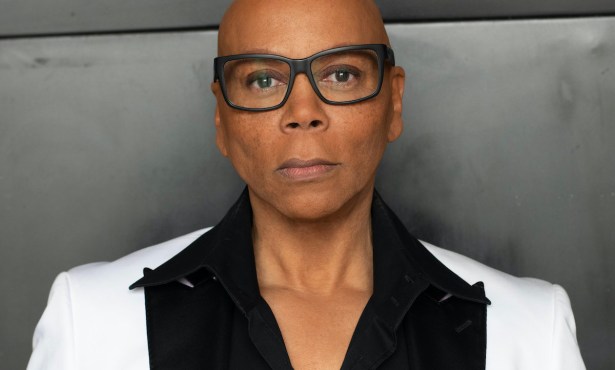Monique Meunier Joins UCSB Dance Department
Former N.Y.C. Ballet Principal Dancer’s Message of Diversity
Monique Meunier is standing quietly in the wings of the New York State Theater, her profile cast in a shade of soft blue as she awaits her entrance cue. From her position, she can catch glimpses of the shimmering set decor, a fantastical landscape abstraction covered in Jackson Pollock–like splashes of gray and indigo that are echoed on her costume’s bodice. She takes a deep breath and pauses. The corps de ballet clears the stage, and the audience rustles with anticipation. Tchaikovsky’s score shifts dramatically, and in one grand jeté, Meunier is suddenly onstage, a powerhouse vision in satin and tulle, her skyward legs lifting her confidently into New York City Ballet history. “I felt like my dreams were unfolding in front of my eyes,” she would recount years later, “as if I was being carried on a journey that I had envisioned over and over in my head.”
Critics would pronounce the principal dancer’s 1999 turn as Odette/Odile in the company’s first ever full-length presentation of the famed Swan Lake ballet as a “wonderful amplitude of shape and flow,” and as a dancer who “knew best how to infuse drama and rapport” into the Swan Queen and her malicious double. To Meunier, Swan Lake was the ultimate opportunity to flex the wide range of talents she’d honed throughout her training. “I’ve always considered myself to be a multifaceted artist,” she explained, “and getting to be both beautifully romantic and deliciously bad in one performance was a dream come true for me.”
The road that led Meunier into Lincoln Center on that momentous evening — one she describes vividly as an awakening to her potential as a dancer — has also informed the path she pursues now that her two-decade performance career is behind her. “The truth is, it felt like a death for me at first,” she recalled. “I had to ask myself what I was supposed to give to now, and teaching became the obvious answer.”
Last autumn, Meunier became the UCSB Department of Theater and Dance’s newest faculty member, a dazzling coup for a university consistently exploring ways to distinguish itself among the six UC schools offering four-year degrees in dance. Her official title, assistant professor of ballet, belies the wide-reaching value her arrival has brought into the department — for both faculty and students alike. “My teaching approach centers on bringing awareness to the value of diversity,” she emphasized. “How to cultivate it, nurture it, and celebrate it.”
Born in Los Angeles to a Cuban mother and an Ecuadorian father, Meunier began taking dance lessons at the age of 4, and, despite suggestions from instructors to pursue a jazz track, knew early on that she wanted to become a ballerina. “I loved the discipline and power of tackling challenging jumps and turns,” she said, “and the music would take you to this far-off place.” Under the guidance of ballet mistress Irena Komoskova, she slipped on a pair of pointe shoes at the age of 7 and never looked back.
Meunier reveled in her rigorous schedule, training in the classical style six days a week with panther-like focus and a soaring commitment. But there were unmistakable differences between her and the other dancers, painful incidents that would serve as catalysts for darker days and unbridled determination. “People would encourage me to lose weight, and I would insist that this was me, this was my body structure, but I did end up developing an eating disorder at 14,” she remembered. There were also more subtle hints directed at her ethnicity, including reassurances that her fairer complexion and lighter hair might allow her to pass as a Caucasian dancer. “They would look straight at me and say it as if it were a compliment, as if I would otherwise be ashamed of being Latin,” Meunier stated.
Sekani Robinson, a UCSB sociology researcher whose doctoral dissertation explores race and gender in the ballet world, believes that dancers of color are exposed to an unaddressed set of challenges that makes it harder to sustain a career in ballet. “Let’s set aside the cultural and economic forces that encourage or discourage a dancer to follow a certain career track,” she said thoughtfully, “and look at some of the small hints that suggest to a dancer of color she doesn’t belong.” Robinson pointed to her own experience as a young dancer, when her mom would spend hours dying her leotards and tights to match her skin tone, even using face makeup to darken her ballet shoes. “I loved ballet,” she said earnestly, “and would have stuck with it had I found one single person that looked like me, that could empathize with my particular experience.” Former Alvin Ailey company member and Santa Barbara resident Christina Sanchez agreed, describing her symbiotic relationship with another Latina dancer at the Alvin Ailey School as the kind of kinship she needed to get through demanding days. “She was a reflection of me, and we pushed each other to be better dancers,” Sanchez recalled. “If she lifted her leg high, I’d need to lift mine higher — the kind of healthy competition peers need to be better than they thought they could be.”
Schools of Change
In recent years, the subject of diversifying our nation’s ballet companies and conservatories has been a pressing topic at trade forums and roundtable discussions, with organizations such as Dance/USA hosting several panel presentations during its annual conference on themes that ranged from equity in promotion to racial aesthetics. In the educational sector, the School of American Ballet (SAB) — arguably the country’s most prestigious ballet conservatory and the associate school for New York City Ballet — made headlines when it announced that its admissions format would now include free, community auditions in multiple locations throughout the outer boroughs alongside its traditional in-school presentations in the hopes of facilitating a more diverse talent pool.
Their scholarship program also continues to be among the best, offering students like Meunier — who auditioned and was admitted to SAB at the age of 15 on a full scholarship — the opportunity to train at a level that might not otherwise be economically feasible. “With a scholarship and a stipend, my mom and I could afford to make the move to New York and find a little place right by the school,” she said. “That opportunity made all of the difference.” The school’s payoff would come a year later when Meunier was accepted into City Ballet as a corps member, and then again and again as she climbed the ranks to soloist and finally to the highest echelon as a principal dancer, becoming one of only a handful of Latinas in the world ever to hold the title for a major ballet company.
Many industry leaders believe that encouraging a kaleidoscope of skin shades and body types in the ballet world begins in the classroom, where a glance around the studio tends to reveal a sea of homogenization that might feel daunting to a person of color. “It’s already hard enough to enroll in a ballet class when all of your friends are doing other after-school activities,” stated Robinson. “Having just one person beside you who looks a little more like you can feel comforting to a young dancer.”
Aesha Ash, the only African-American dancer during most of her near-decade career with City Ballet in the late ’90s, often speaks candidly in public about the isolation she felt during her time at SAB, recounting stories of makeup artists who would decline to work with her because their color palettes didn’t include anything for her skin tone, or how other ballerinas would laugh at the state of her curly hair after a performance. “It’s surprising how much racism still exists in ballet,” remarked Meunier. “Shocking but not shocking.”
Dancers often point to the presence of role models as conduits to a budding dance interest, and the glue that holds their passion intact when fatigue and doubt begin to seep in. “I didn’t know professional black ballerinas even existed when I was taking classes,” Robinson remembered, “and had I known, maybe things would have gone differently for me.” In recent years, young dancers of color cite American Ballet Theatre’s (ABT) first African-American principal dancer, Misty Copeland, as a catalyst to their interest in ballet (Copeland often cites Ash as her go-to for inspiration, and Ash in turn references Andrea Long as hers) creating a butterfly effect that many scholars believe is the key to ushering in a freshly diverse ballet landscape. But it won’t be fully realized, they stress, without addressing the lack of diversity in the instructors and directors, who are the everyday faces of a staunchly traditional institution, and who might not be privy to the alienation non-whites feel in a classroom setting.
In 2013, ABT launched an initiative, Project Plié, to address that conundrum, extending its search for promising young dancers of color to include dance teachers and arts administrators. “Remember that most teachers end up deciding the track for a student,” said Meunier, “and they may not always believe you have a chance in ballet, because you don’t fit the look.” Robinson agreed, recalling a well-intentioned ballet instructor who encouraged her to pursue modern dance, believing she would have a better shot at a long-term career.
With the recent hiring of two Latino professors — Brandon Whited, who is half Puerto Rican, was brought on board several months before Meunier — the UCSB Dance Department is taking a step in the right direction toward expanding the ethnicity of the faculty, which is disproportionately white. In a recent phone interview, Christina McCarthy, vice-chair of the UCSB Department of Theatre and Dance, shared that it took the sobering words of a colleague to open up a dialogue about inclusivity. “To be honest, I never really thought about my points of view as based on my [race] until it was brought up,” she said. “It makes you look at things from a completely different angle.” McCarthy also stressed that although diversity is an important factor in a university’s hiring methods, she would never want to sacrifice quality in the process. Robinson believes that one doesn’t have to preclude the other. “History has shown us that there is no lack of ability from people of color, simply a lack of recognition.” She and McCarthy are currently in talks about exploring ways to weave her extensive research on the history of race and dance into the department’s curriculum, effectively opening up a broader conversation about the influence an educational institution can have toward enduring change.
Meunier’s Humanitarian Message
Since her arrival last fall, Meunier has wasted no time in rolling up her sleeves and injecting real-life experience into her teaching methods, forging new relationships with faculty members in an effort to collaborate on what she refers to as “art with a humanitarian message.” In late January, she partnered with the university’s Art, Design & Architecture Museum to curate an evening of multidisciplinary work, titled Still We Rise, in response to the government’s announcement that it would be discontinuing the Deferred Action for Childhood Arrivals (DACA) program.
Meunier invited faculty from the Department of Theater and Dance and the College of Creative Studies to perform alongside some of her dance students for two packed-house evenings of poetry, theater, and dance that brought a message of urgency and compassion directly on campus, where many DACA participants are currently enrolled. Meunier is also calling on an esteemed network of colleagues to help spread her message of inclusivity, beginning with Misty Copeland, who will join a panel of area and national diversity scholars and educators on December 10 in an inspiring conversation about pride and perseverance to an audience of Santa Barbara High School students. As if that weren’t enough, Meunier has convinced Maria Kowroski and Tyler Angle, two principal dancers at City Ballet, to take a few days off from their frenetic Nutcracker schedule to perform in Meunier’s latest work, premiering on December 6 at the UCSB Dance Department’s fall concert.
It’s easy to spot Meunier in a crowded café. When we meet to discuss her Hatlen Theater debut, she is sitting at a corner table, effortlessly upright and chin tilted toward the ceiling, a demeanor lit up with electric presence. Over the past few weeks, she’s been dedicating her Saturdays to the creation of “Memory of Hope,” the piece that will be closing out the fall program. The commitment adds an extra day to her already busy teaching schedule, but Meunier seems unfazed by the prospect. Twenty dance majors have signed on to spend Saturday mornings alongside her when they could otherwise be catching up on sleep — a testament to her ability for inspiring dedication in her young students.
The new piece, an emotionally gripping work about the isolation and anxiety that plagues a person battling with depression, is dedicated to the passing of Meunier’s beloved mentor Peter Frame, a former City Ballet dancer and SAB instructor who committed suicide in late August. “There was really no one like him,” Meunier said. “He was loving and giving and so incredibly supportive.” There is a pas de deux inside of “Memory of Hope” inspired by “Peter’s calmness, and memories of better times,” said Meunier, and on Thursday evening, UCSB dancers Kaylene Garcia and Ezra Spencer will step into the formidable roles before Kowroski and Angle take the stage Friday-Saturday, December 7-8. Rounding out the evening will be works by faculty members Valerie Huston and Christopher Pilafian, as well as the restaging of “The Unsung” (1971) and “Re-III” (2009) by famed choreographers José Limón and Shen Wei, respectively.
When Meunier reflects on her decades-long dance career, she could easily be describing a neoclassical ballet, stripped of excess romanticism and heavy theatrics so that only the aesthetics of pure movement and the dance itself appear in the foreground of her memory. And Meunier’s new roles, as mentor and mother and wife, are ones she takes on with a pragmatism and dedication so authentic in execution that you have no doubt she’ll be able to bring it all together into one rousing suite. “Everyone needs to understand who they are in life, the solid base that holds them firmly in place,” she said. “Dance has always been that for me. It was my first love, before I knew anything else about life, and it will always define how I walk through this world.”
4•1•1
Monique Meunier’s “Memory of Hope” premieres at the UCSB Dance Department’s fall concert, which runs Thursday-Saturday, December 6-8, at UCSB’s Hatlen Theater. Call 893-2064 or see theaterdance.ucsb.edu.



